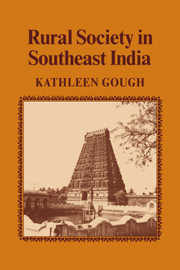Book contents
- Frontmatter
- Contents
- Preface
- Part I Thanjāvūr
- Part II Kumbapeṭṭai
- 8 The Face of the Village
- 9 Kumbapeṭṭai before 1855
- 10 Kumbapeṭṭai from 1855 to 1952
- 11 The Annual Round
- 12 Economics and Class Structure: The Petty Bourgeoisie
- 13 Independent Commodity Producers and Traders
- 14 The Semiproletariat
- 15 Village Politics: Religion, Caste, and Class
- 16 Village Politics: The Street Assembly
- 17 Class Struggle and Village Power Structure
- Part III Kirippūr
- Notes
- Glossary
- Bibliography
- Index
- CAMBRIDGE STUDIES IN SOCIAL ANTHROPOLOGY
14 - The Semiproletariat
from Part II - Kumbapeṭṭai
Published online by Cambridge University Press: 29 October 2009
- Frontmatter
- Contents
- Preface
- Part I Thanjāvūr
- Part II Kumbapeṭṭai
- 8 The Face of the Village
- 9 Kumbapeṭṭai before 1855
- 10 Kumbapeṭṭai from 1855 to 1952
- 11 The Annual Round
- 12 Economics and Class Structure: The Petty Bourgeoisie
- 13 Independent Commodity Producers and Traders
- 14 The Semiproletariat
- 15 Village Politics: Religion, Caste, and Class
- 16 Village Politics: The Street Assembly
- 17 Class Struggle and Village Power Structure
- Part III Kirippūr
- Notes
- Glossary
- Bibliography
- Index
- CAMBRIDGE STUDIES IN SOCIAL ANTHROPOLOGY
Summary
The semiproletariat consisted of those who did manual labor for one or more masters and who surrendered their surplus product either as rent or as surplus value to their employers. I have included in this class the village servants who had no substantial source of livelihood other than their hereditary work. Like the tenant farmers and agricultural laborers, the village servants carried on their work for the village in return for little more than subsistence payments. Their level of living was similar to that of the tenant cultivators and agricultural laborers. They associated closely with these groups, and if they became too numerous, some took up tenant farming or agricultural labor for a livelihood.
The semiproletariat had two clearly defined strata, one of which was seen as, and was usually in fact, slightly more prosperous than the other. The upper layer consisted of those who owned most or all of their own tools of production and carried on the major part of their work without supervision by a master. It included the kuthakai tenants and most of the village servants. The lower layer consisted of those who owned few or no tools or equipment, who worked mainly under supervision, or who could provide only what Tanjoreans called “body help” to their masters. It included the agricultural laborers together with two groups of village servants, the Parayar scavengers, and the Paḷḷar watchmen of the paddy fields.
- Type
- Chapter
- Information
- Rural Society in Southeast India , pp. 260 - 288Publisher: Cambridge University PressPrint publication year: 1982

